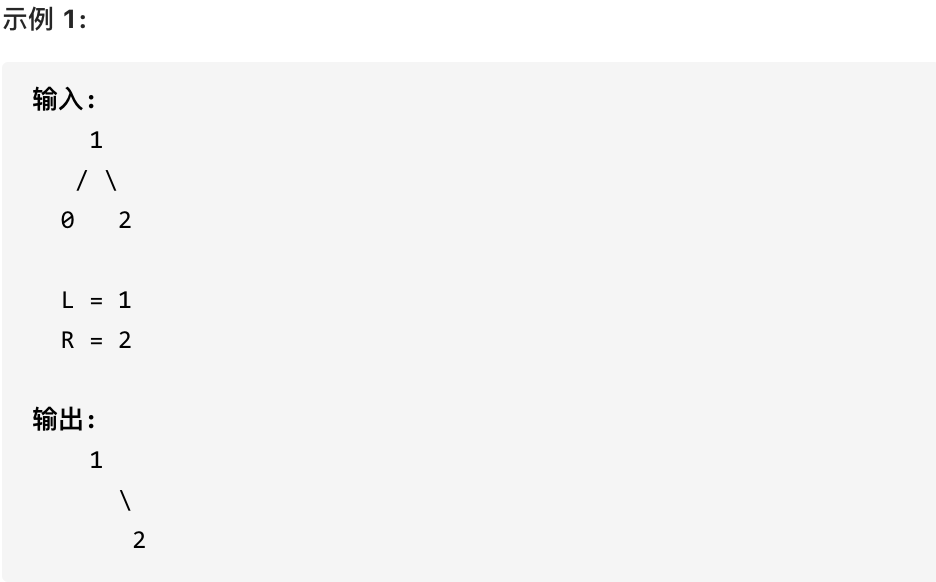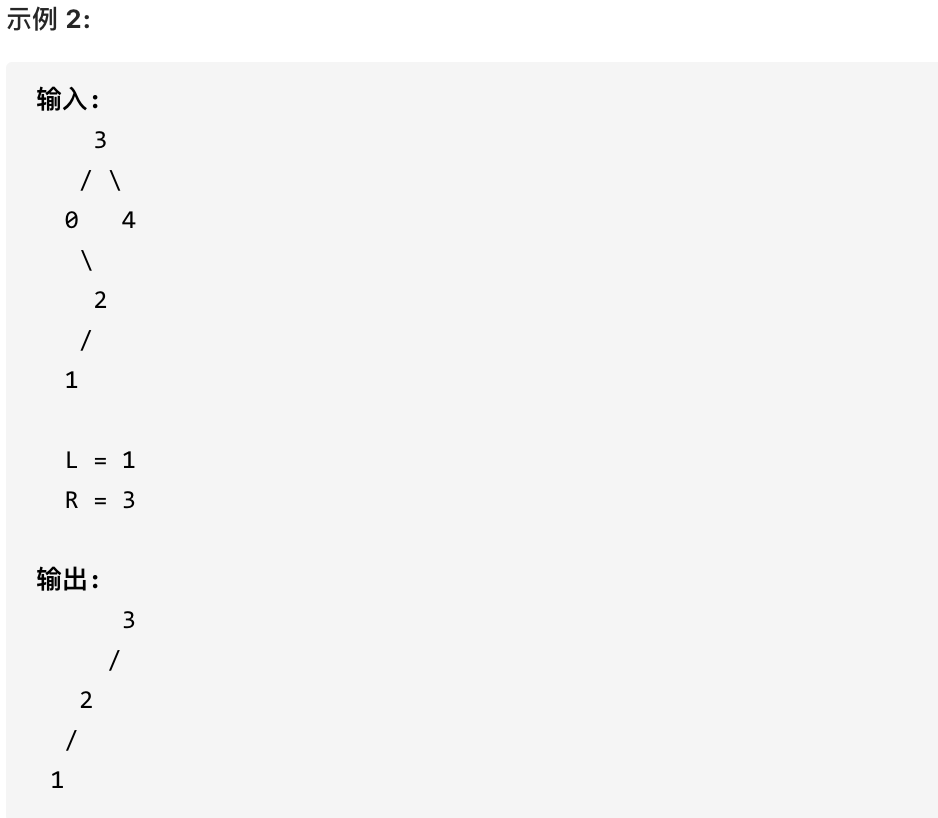0669.修剪二叉搜索树
参与本项目,贡献其他语言版本的代码,拥抱开源,让更多学习算法的小伙伴们收益!
> 如果不对递归有深刻的理解,本题有点难 > 单纯移除一个节点那还不够,要修剪! # 669. 修剪二叉搜索树 [力扣题目链接](https://leetcode.cn/problems/trim-a-binary-search-tree/) 给定一个二叉搜索树,同时给定最小边界L 和最大边界 R。通过修剪二叉搜索树,使得所有节点的值在[L, R]中 (R>=L) 。你可能需要改变树的根节点,所以结果应当返回修剪好的二叉搜索树的新的根节点。   ## 算法公开课 **[《代码随想录》算法视频公开课](https://programmercarl.com/other/gongkaike.html):[你修剪的方式不对,我来给你纠正一下!| LeetCode:669. 修剪二叉搜索树](https://www.bilibili.com/video/BV17P41177ud?share_source=copy_web),相信结合视频在看本篇题解,更有助于大家对本题的理解**。 ## 思路 相信看到这道题目大家都感觉是一道简单题(事实上leetcode上也标明是简单)。 但还真的不简单! ### 递归法 直接想法就是:递归处理,然后遇到 `root->val < low || root->val > high` 的时候直接return NULL,一波修改,赶紧利落。 不难写出如下代码:class Solution {
public:
TreeNode* trimBST(TreeNode* root, int low, int high) {
if (root == nullptr || root->val < low || root->val > high) return nullptr;
root->left = trimBST(root->left, low, high);
root->right = trimBST(root->right, low, high);
return root;
}
};
if (root->val < low) {
TreeNode* right = trimBST(root->right, low, high); // 寻找符合区间[low, high]的节点
return right;
}
if (root->val > high) {
TreeNode* left = trimBST(root->left, low, high); // 寻找符合区间[low, high]的节点
return left;
}
root->left = trimBST(root->left, low, high); // root->left接入符合条件的左孩子
root->right = trimBST(root->right, low, high); // root->right接入符合条件的右孩子
return root;
if (root->val < low) {
TreeNode* right = trimBST(root->right, low, high); // 寻找符合区间[low, high]的节点
return right;
}
class Solution {
public:
TreeNode* trimBST(TreeNode* root, int low, int high) {
if (root == nullptr ) return nullptr;
if (root->val < low) {
TreeNode* right = trimBST(root->right, low, high); // 寻找符合区间[low, high]的节点
return right;
}
if (root->val > high) {
TreeNode* left = trimBST(root->left, low, high); // 寻找符合区间[low, high]的节点
return left;
}
root->left = trimBST(root->left, low, high); // root->left接入符合条件的左孩子
root->right = trimBST(root->right, low, high); // root->right接入符合条件的右孩子
return root;
}
};
class Solution {
public:
TreeNode* trimBST(TreeNode* root, int low, int high) {
if (root == nullptr) return nullptr;
if (root->val < low) return trimBST(root->right, low, high);
if (root->val > high) return trimBST(root->left, low, high);
root->left = trimBST(root->left, low, high);
root->right = trimBST(root->right, low, high);
return root;
}
};
class Solution {
public:
TreeNode* trimBST(TreeNode* root, int L, int R) {
if (!root) return nullptr;
// 处理头结点,让root移动到[L, R] 范围内,注意是左闭右闭
while (root != nullptr && (root->val < L || root->val > R)) {
if (root->val < L) root = root->right; // 小于L往右走
else root = root->left; // 大于R往左走
}
TreeNode *cur = root;
// 此时root已经在[L, R] 范围内,处理左孩子元素小于L的情况
while (cur != nullptr) {
while (cur->left && cur->left->val < L) {
cur->left = cur->left->right;
}
cur = cur->left;
}
cur = root;
// 此时root已经在[L, R] 范围内,处理右孩子大于R的情况
while (cur != nullptr) {
while (cur->right && cur->right->val > R) {
cur->right = cur->right->left;
}
cur = cur->right;
}
return root;
}
};
class Solution {
public TreeNode trimBST(TreeNode root, int low, int high) {
if (root == null) {
return null;
}
if (root.val < low) {
return trimBST(root.right, low, high);
}
if (root.val > high) {
return trimBST(root.left, low, high);
}
// root在[low,high]范围内
root.left = trimBST(root.left, low, high);
root.right = trimBST(root.right, low, high);
return root;
}
}
class Solution {
//iteration
public TreeNode trimBST(TreeNode root, int low, int high) {
if(root == null)
return null;
while(root != null && (root.val < low || root.val > high)){
if(root.val < low)
root = root.right;
else
root = root.left;
}
TreeNode curr = root;
//deal with root's left sub-tree, and deal with the value smaller than low.
while(curr != null){
while(curr.left != null && curr.left.val < low){
curr.left = curr.left.right;
}
curr = curr.left;
}
//go back to root;
curr = root;
//deal with root's righg sub-tree, and deal with the value bigger than high.
while(curr != null){
while(curr.right != null && curr.right.val > high){
curr.right = curr.right.left;
}
curr = curr.right;
}
return root;
}
}
````
### Python
递归法(版本一)
```python
class Solution:
def trimBST(self, root: TreeNode, low: int, high: int) -> TreeNode:
if root is None:
return None
if root.val < low:
# 寻找符合区间 [low, high] 的节点
return self.trimBST(root.right, low, high)
if root.val > high:
# 寻找符合区间 [low, high] 的节点
return self.trimBST(root.left, low, high)
root.left = self.trimBST(root.left, low, high) # root.left 接入符合条件的左孩子
root.right = self.trimBST(root.right, low, high) # root.right 接入符合条件的右孩子
return root
class Solution:
def trimBST(self, root: TreeNode, L: int, R: int) -> TreeNode:
if not root:
return None
# 处理头结点,让root移动到[L, R] 范围内,注意是左闭右闭
while root and (root.val < L or root.val > R):
if root.val < L:
root = root.right # 小于L往右走
else:
root = root.left # 大于R往左走
cur = root
# 此时root已经在[L, R] 范围内,处理左孩子元素小于L的情况
while cur:
while cur.left and cur.left.val < L:
cur.left = cur.left.right
cur = cur.left
cur = root
# 此时root已经在[L, R] 范围内,处理右孩子大于R的情况
while cur:
while cur.right and cur.right.val > R:
cur.right = cur.right.left
cur = cur.right
return root
// 递归
func trimBST(root *TreeNode, low int, high int) *TreeNode {
if root == nil {
return nil
}
if root.Val < low { //如果该节点值小于最小值,则该节点更换为该节点的右节点值,继续遍历
right := trimBST(root.Right, low, high)
return right
}
if root.Val > high { //如果该节点的值大于最大值,则该节点更换为该节点的左节点值,继续遍历
left := trimBST(root.Left, low, high)
return left
}
root.Left = trimBST(root.Left, low, high)
root.Right = trimBST(root.Right, low, high)
return root
}
// 迭代
func trimBST(root *TreeNode, low int, high int) *TreeNode {
if root == nil {
return nil
}
// 处理 root,让 root 移动到[low, high] 范围内,注意是左闭右闭
for root != nil && (root.Val < low || root.Val > high) {
if root.Val < low {
root = root.Right
} else {
root = root.Left
}
}
cur := root
// 此时 root 已经在[low, high] 范围内,处理左孩子元素小于 low 的情况(左节点是一定小于 root.Val,因此天然小于 high)
for cur != nil {
for cur.Left != nil && cur.Left.Val < low {
cur.Left = cur.Left.Right
}
cur = cur.Left
}
cur = root
// 此时 root 已经在[low, high] 范围内,处理右孩子大于 high 的情况
for cur != nil {
for cur.Right != nil && cur.Right.Val > high {
cur.Right = cur.Right.Left
}
cur = cur.Right
}
return root
}
var trimBST = function(root, low, high) {
if(root === null) {
return null;
}
while(root !== null && (root.val < low || root.val > high)) {
if(root.val < low) {
root = root.right;
}else {
root = root.left;
}
}
let cur = root;
while(cur !== null) {
while(cur.left && cur.left.val < low) {
cur.left = cur.left.right;
}
cur = cur.left;
}
cur = root;
//判断右子树大于high的情况
while(cur !== null) {
while(cur.right && cur.right.val > high) {
cur.right = cur.right.left;
}
cur = cur.right;
}
return root;
};
var trimBST = function (root,low,high) {
if(root === null) {
return null;
}
if(root.val < low) {
let right = trimBST(root.right, low, high);
return right;
}
if(root.val > high) {
let left = trimBST(root.left, low, high);
return left;
}
root.left = trimBST(root.left, low, high);
root.right = trimBST(root.right, low, high);
return root;
}
function trimBST(root: TreeNode | null, low: number, high: number): TreeNode | null {
if (root === null) return null;
if (root.val < low) {
return trimBST(root.right, low, high);
}
if (root.val > high) {
return trimBST(root.left, low, high);
}
root.left = trimBST(root.left, low, high);
root.right = trimBST(root.right, low, high);
return root;
};
function trimBST(root: TreeNode | null, low: number, high: number): TreeNode | null {
while (root !== null && (root.val < low || root.val > high)) {
if (root.val < low) {
root = root.right;
} else if (root.val > high) {
root = root.left;
}
}
let curNode: TreeNode | null = root;
while (curNode !== null) {
while (curNode.left !== null && curNode.left.val < low) {
curNode.left = curNode.left.right;
}
curNode = curNode.left;
}
curNode = root;
while (curNode !== null) {
while (curNode.right !== null && curNode.right.val > high) {
curNode.right = curNode.right.left;
}
curNode = curNode.right;
}
return root;
};
object Solution {
def trimBST(root: TreeNode, low: Int, high: Int): TreeNode = {
if (root == null) return null
if (root.value < low) return trimBST(root.right, low, high)
if (root.value > high) return trimBST(root.left, low, high)
root.left = trimBST(root.left, low, high)
root.right = trimBST(root.right, low, high)
root
}
}
impl Solution {
pub fn trim_bst(
root: Option<Rc<RefCell<TreeNode>>>,
low: i32,
high: i32,
) -> Option<Rc<RefCell<TreeNode>>> {
root.as_ref()?;
let mut node = root.as_ref().unwrap().borrow_mut();
if node.val < low {
return Self::trim_bst(node.right.clone(), low, high);
}
if node.val > high {
return Self::trim_bst(node.left.clone(), low, high);
}
node.left = Self::trim_bst(node.left.clone(), low, high);
node.right = Self::trim_bst(node.right.clone(), low, high);
drop(node);
root
}
}
// 递归
public TreeNode TrimBST(TreeNode root, int low, int high)
{
if (root == null) return null;
if (root.val < low)
return TrimBST(root.right, low, high);
if (root.val > high)
return TrimBST(root.left, low, high);
root.left = TrimBST(root.left, low, high);
root.right = TrimBST(root.right, low, high);
return root;
}

